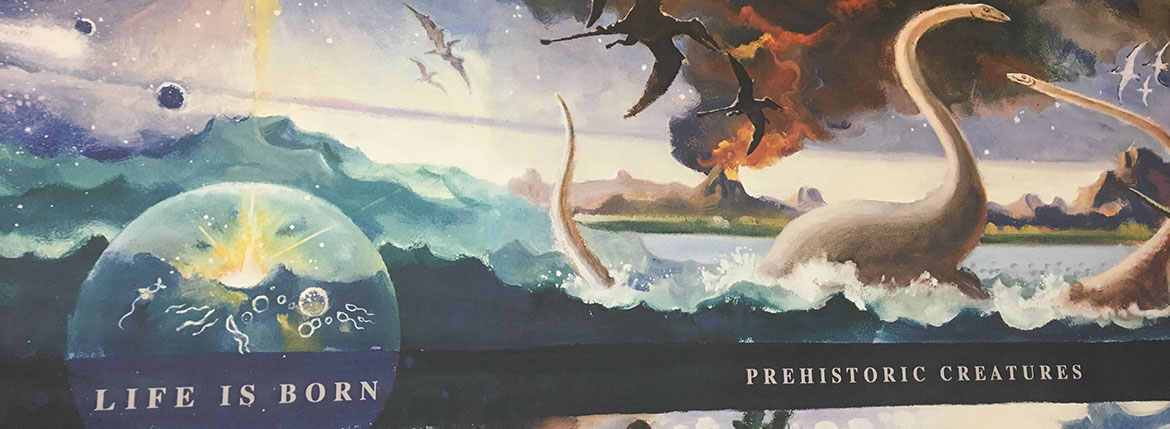
A mural from the Arizona Challenger Space Center. The center is involved in the Science of Baseball STEM Showcase at Chase Field. (Photo by Eddie Poe/Cronkite Sports)
PHOENIX — The Arizona Diamondbacks will welcome more than 5,000 Arizona K-12 students and their families to Chase Field on Friday as part of their fourth annual Science of Baseball STEM Showcase.
Throughout the ballpark, fans will have the opportunity to visit interactive exhibits and meet with experts in the fields of science, technology, engineering and math. One of those exhibits will come courtesy of the Arizona Challenger Space Center.
“It’s been a project of ours for several years,” said Beverly Swayman, executive director of Challenger Space Center. “The thing that (they) love about what we bring is that we have huge inflatable planets that show the difference in sizes between all of the planets and how they relate to Earth.”
An affiliate of the Smithsonian Institution, the space center opened in Peoria in 2000 and pays tribute to space exploration and the astronauts lost in the 1986 Challenger disaster. It is one of four centers that are independently funded and the only one in Arizona.
The mission of Swayman and those at the space center has simply been to educate and inspire children and to help them understand the world they live in and the universe beyond.
This year’s exhibit will include a robotics section to go along with its giant replica of planets that have been a particular fascination for children in years past.
“We find that this is an exciting new field and that it also relates to space travel because we need robots to help us explore these planets,” Swayman said. “These things help to inspire and encourage students of all ages to be able to explore what they’re curious about.”
Introduced in 2013, the objective of the Diamondbacks Science of Baseball program is to promote STEM through classroom theory and practical applications of baseball. It aims to train elementary and middle school teachers to provide a university research-based curriculum that will engage and empower students.
“I think if you bring all of the principles of STEM together, you begin to see that there are things that help out all of us when it comes to learning,” Swayman said. “If we bring all of those principles together and figure out what is common between each of them, it makes for a better learning experience and it opens doors to creativity and innovation.”
The perspective of encouragement through education is something the Challenger Space Center and Diamondbacks share. The commonalities are evident in the desire for students to learn and gain knowledge in the many different areas of STEM.
“We are really encouraged by the support we’ve received from the Diamondbacks,” Swayman said. “They have been extraordinarily supportive in allowing us to bring this type of exhibit to this forum.”
The 28,000-square-foot building that houses a flight simulator, artifacts and several displays has been sold. The team at the space center is currently clearing out the facility and in ongoing negotiations for a new home.
Even though the process has been strenuous and will require a breather for staff, they are optimistic about what the future holds for Challenger Space Center.
“The places we are looking at will be significantly larger than what we currently have,” education director Jon Van de Water said. “By having more space, we’ll be able to have more programs, more exhibits, and be able to excite the Phoenix-metro area as well as the state of Arizona about STEM education.”
Relocation also means that the center’s 360-degree mural painted by artist Robert McCall, reportedly his last before his death in 2010, will have to be left behind due to the risks of damage that could result from removing it.
Swayman and Van de Water are hopeful that the new owners will appreciate the mural and continue to make it available to the public.
As Challenger Space Center moves towards the next stage of its existence, new opportunities will allow for more encouragement and empowerment through STEM education.
“We’re hopeful as we begin to make this move that we’re going to be able to have a thoughtful process about what the future holds and what types of technologies and skills kids will need,” Swayman said. “We’re encouraged that the communities that have welcomed us and are excited about us coming, are very supportive about the work that we do.
“We are grateful that we’ve had this opportunity but we’re even more excited about the future.”